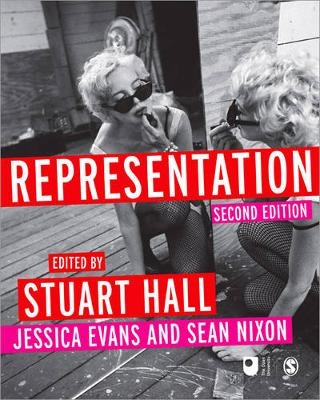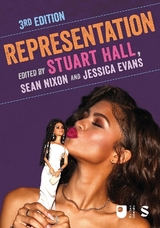
Representation
SAGE Publications Ltd (Verlag)
978-1-84920-563-4 (ISBN)
Since 1997 Representation has been the go-to textbook for students learning the tools to question and critically analyze institutional and media texts and images. This long-awaited second edition:
• updates and refreshes the approaches to representation, signalling key developments in the field
• addresses the emergence of new technologies, media formats, politics and theories
• includes an entirely new chapter on celebrity culture and reality TV
• offers new exercises, readings, images and examples for a new generation of students
This book once again provides an indispensible resource for students and teachers in cultural and media studies.
Stuart Hall was born and raised in Jamaica and arrived in Britain on a Rhodes scholarship to Oxford in 1950. In 1958, he left his PhD on Henry James to found the New Left Review, which did much to open a debate about immigration and the politics of identity. Along with Raymond Williams and Richard Hoggart he established the first Cultural Studies programme at a British university in Birmingham in 1964, bringing the study of popular culture into the understanding of political and social change. After spending more than four decades as one of the UK’s leading public intellectuals, Hall retired from formal academic life in 1997 and since then has continued to devote himself to questions of representation, creativity and difference. He became the chair of two foundations, Iniva, the Institute of International Visual Arts, and Autograph ABP, which seeks to promote photographers from culturally diverse backgrounds, and championed the opening of Iniva’s new Rivington Place arts complex in east London in 2007. Jessica Evans is Senior Lecturer in Cultural & Media Studies at the Open University. Professor Sean Nixon is Head of the Department of Sociology and Director of MA Advertising and Marketing and the Media. at the University of Essex.
THE WORK OF REPRESENTATION - Stuart Hall
Representation, Meaning and Language
Making Meaning, Representing Things
Language and Representation
Sharing the Codes
Theories of Representation
The Language of Traffic Lights
Summary
Saussure′s Legacy
The Social Part of Language
Critique of Saussure′s Model
Summary
From Language to Culture: Linguistics to Semiotics
Myth Today
Discourse, Power and the Subject
From Language to Discourse
Historicizing Discourse: Discursive Practices
From Discourse to Power/Knowledge
Summary: Foucault and Representation
Charcot and the Performance of Hysteria
Where is the ′Subject′?
How to Make Sense of Velasquez′ Las Meninas
The Subject of/in Representation
Conclusion: Representation, Meaning and Language Reconsidered
READING A: Norman Bryson, ′Language, reflection and still life′
READING B: Roland Barthes, ′The world of wrestling′
READING C: Roland Barthes, ′Myth today′
READING D: Roland Barthes, ′Rhetoric of the image′
READING E: Ernesto Laclau and Chantal Mouffe, New reflections on the revolution of our time
READING F: Elaine Showalter, ′The performance of hysteria′
RECORDING REALITY: DOCUMENTARY FILM AND TELEVISION - Frances Bonner
Introduction
What Do We Mean By ′Documentary′?
Non-fiction Texts
Defining Documentary
Types of Documentary
Categorising Documentary
Alternative Categories
Ethical Documentary Film-making
Dramatisation and the Documentary
Scripting and Re-enactment in the Documentary
Docudrama
Documentary - An Historic Genre?
′Postdocumentary′?
Docusoaps
Reality TV
Natural History Documentaries
Documenting Animal Life
Conclusion
READING A: Nichols Bill, ′The Qualities of Voice′
READING B: John Corner, ′Performing the real: documentary diversions′
READING C: Derek Bousé, ′Historia Fabulosus′
THE POETICS AND THE POLITICS OF EXHIBITING OTHER CULTURES - Henrietta Lidchi
Introduction
Establishing Definitions, Negotiating Meanings, Discerning Objects
Introduction
What is a ′Museum′?
What is an ′Ethnographic Museum′?
Objects and Meanings
The Uses of Text
Questions of Context
Summary
Fashioning Cultures: The Poetics of Exhibiting
Introduction
Introducing Paradise
Paradise Regained
Structuring Paradise
Paradise: The Exhibit as Artefact
The Myths of Paradise
Summary
Captivating Cultures: The Politics of Exhibiting
Introduction
Knowledge and Power
Displaying Others
Museums and the Construction of Culture
Colonial Spectacles
Summary
Devising New Models: Museums and Their Futures
Introduction
Anthropology and Colonial Knowledge
The Writing of Anthropological Knowledge
Collections as Partial Truths
Museums and Contact Zones
Art, Artefact and Ownership
Conclusion
READING A: John Tradescant the younger, ′Extracts from the Musaeum Tradescantianum′
READING B: Elizabeth A. Lawrence, ′His very silence speaks: the horse who survived Custer′s Last Stand′
READING C: Michael O′Hanlon, ′Paradise: portraying the New Guinea Highlands′
READING D: James Clifford, ′Paradise′
READING E: Annie E. Coombes, ′Material culture at the crossroads of knowledge: the case of the Benin "bronzes′"
READING F: John Picton, ′To see or Not To See! That is the Question′
THE SPECTACLE OF THE ′OTHER′ - Stuart Hall
Introduction
Heroes or Villains?
Why Does ′Difference′ Matter?
Racializing the ′Other′
Commodity Racism: Empire and the Domestic World
Meanwhile, Down on the Plantation ...
Signifying Racial ′Difference′
Staging Racial ′Difference′: ′And the Melody Lingered On...′
Heavenly Bodies
Stereotyping as a Signifying Practice
Representation, Difference and Power
Power and Fantasy
Fetishism and Disavowal
Contesting a Recialized Regime of Representation
Reversing the Stereotypes
Positive and Negative Images
Through the Eye of Representation
Conclusion
READING A: Anne McClintock, ′Soap and commodity spectacle′
READING B: Richard Dyer, ′Africa′
READING C: Sander Gilman, ′The deep structure of stereotypes′
READING D: Kobena Mercer, ′Reading racial fetishism′
EXHIBITING MASCULINITY - Sean Nixon
Introduction
Conceptualizing Masculinity
Plural Masculinities
Thinking Relationally
Invented Categories
Summary
Discourse and Representation
Discourse, Power/Knowledge and the Subject
Visual Codes of Masculinity
′Street Style′
′Italian-American′
′Conservative Englishness′
Summary
Spectatorship and Subjectivization
Psychoanalysis and Subjectivity
Spectatorship
The Spectacle of Masculinity
The Problem with Psychoanalysis and Film Theory
Techniques of the Self
Consumption and Spectatorship
Sites of Representation
Just Looking
Spectatorship, Consumption and the ′New Man′
Conclusion
READING A: Steve Neale, ′Masculinity as spectacle′
READING B: Sean Nixon, ′Technologies of looking: retailing and the visual′
GENRE AND GENDER: THE CASE OF SOAP OPERA - Christine Gledhill with Vicky Ball
Introduction
Representation and Media Fictions
Fiction and Everyday Life
Fiction as Entertainment
But is it Good For You?
Mass Culture and Gendered Culture
Women′s Culture and Men′s Culture
Images of Women vs. Real Women
Entertainment as a Capitalist Industry
Dominant Ideology, Hegemony and Cultural Negotiation
The Gendering of Cultural Forms: High Culture vs. Mass Culture
Genre, Representation and Soap Opera
The Genre System
The Genre Product
Genre and Mass-produced Fiction
Genre as Standardization and Differentiation
The Genre Product as Text
Genres and Binary Differences
Genre Boundaries
Signification and Reference
Cultural Verisimilitude, Generic Gerisimilitude and Realism
Media Production and Struggles for Hegemony
Summary
Genres for Women: Te Case of Soap Opera
Genre, Soap Opera and Gender
The Invention of Soap Opera
Women′s Culture
Soap Opera as Women′s Genre
Soap Opera′s Binary Oppositions
Serial Form and Gender Representation
Soap Opera′s Address to the Female Audience
Talk vs. Action
Soap Opera′s Serial World
Textual Address and the Construction of Subjects
The Ideal Spectator
Female Reading Competence
Cultural Competence and the Implied Reader of the Text
The Social Audience
Conclusion
Soap Opera: A Woman′s Form No More?
Dissolving Genre Boundaries and Gendered Negotiations
READING A: Tania Modleski, ′The search for tomorrow in today′s soap operas′
READING B: Charlotte Brunsdon, ′Crossroads: notes on soap opera′
READING C: Su Holmes and Deborah Jermyn ′Why not Wife Swap?
Index
| Erscheint lt. Verlag | 15.5.2013 |
|---|---|
| Reihe/Serie | Culture, Media and Identities series |
| Verlagsort | London |
| Sprache | englisch |
| Maße | 186 x 232 mm |
| Gewicht | 780 g |
| Themenwelt | Geisteswissenschaften ► Philosophie ► Erkenntnistheorie / Wissenschaftstheorie |
| Sozialwissenschaften ► Ethnologie | |
| Sozialwissenschaften ► Soziologie | |
| ISBN-10 | 1-84920-563-9 / 1849205639 |
| ISBN-13 | 978-1-84920-563-4 / 9781849205634 |
| Zustand | Neuware |
| Informationen gemäß Produktsicherheitsverordnung (GPSR) | |
| Haben Sie eine Frage zum Produkt? |
aus dem Bereich



